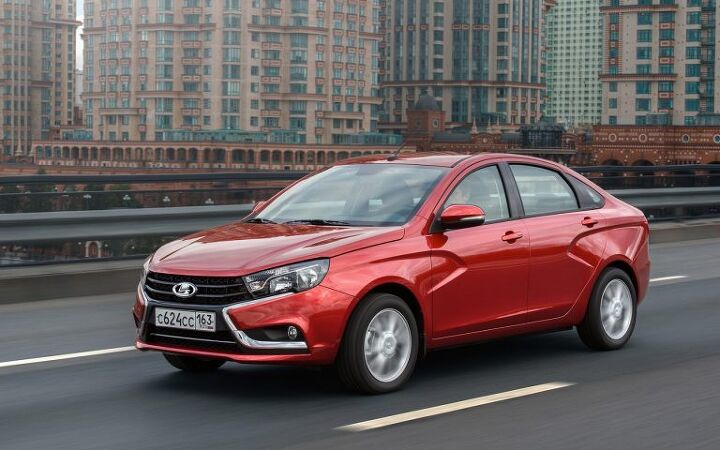Lada: Financial Learnings of Avtovaz for Make Benefit Glorious Nation of Russia

U.S. light vehicle sales sunk slightly in 2017 after years of increases, and this year’s not looking any different. In Russia, however, it’s the opposite situation. After making like the Germans at Stalingrad for the past three years, the Russian car market is now advancing like a T-34 tank — and it has the country’s most famous car brand to thank for it.
Leading the pack is none other than Lada, a company known for cranking out archaic, seemingly indestructible Iron Curtain cars for decades with only minimal changes. That was then, though, and this is now. Spurred by a rebounding economy, sales of new Lada models helped Renault-owned parent company Avtovaz drastically cut its losses in 2017.
Lada’s top brass can give credit to a very Western product strategy.
At the end of 2017 Lada had the country’s top market share, with 19.5 percent of all car and light commercial vehicles sales sold. That’s an increase of 1 percent from 2016. The brand’s domestic retail sales topped last year’s figures by 17 percent in a market that grew by 11.9 percent. Fleet sales rose 32 percent, with exports to other markets — including newcomer China — rising some 44.5 percent.
While the past several years looked especially dire for the industry, the brand’s recent product push was set in motion with the hiring of chief designer Steve Mattin in late 2011. The British-born Mattin, whose background includes top design posts at Mercedes-Benz and Volvo, set about sculpting a new generation of vehicles. The compact Vesta sedan appeared in late 2015 for the 2016 model year, joining a car lineup that included the older (and cheaper) Granta, Kalina, and Priora. In early 2016, the Xray compact crossover debuted.
Lada built on the success of the modern-looking Vesta with last year’s introduction of the Vesta SW wagon and lifted, cladded SW Cross. Yes, Lada has a “Cross” of its own, though this soft-roader is only available in front-drive. It’s a product strategy that resembles Ford of Europe’s small car plan, where one model spawns multiple variants up to and including a faux crossover.
Vesta sedan sales rose 40.1 percent in Russia last year. The Xray, which went on sale in February 2016, saw its volume increase by 67 percent. Apparently, Russians really dig scalloped fenders. If you’re wondering, rest assured that one Cold War warrier still lurks within the brand’s lineup — the Lada 4×4, formerly the Lada Niva, which soldiers on with its unmistakable profile and 1.7-liter engine intact. There’s also a five-door version now.
According to Reuters, Avtovaz president Nicolas Maure expects Lada sales to grow by at least another 10 percent in 2018. Thanks to rising sales and a cost-cutting blitz, the company’s revenues rose 22 percent in 2017, with its net loss shrinking from $790 million to $171 million. The goal for this year is to reach a positive operating margin.
[Images: Lada]

More by Steph Willems
Latest Car Reviews
Read moreLatest Product Reviews
Read moreRecent Comments
- VoGhost Interesting comments. Back in reality, AV is already here, and the experience to date has been that AV is far safer than most drivers. But I guess your "news" didn't tell you that, for some reason.
- Doc423 Come try to take it, Pal. Environmental Whacko.
- 28-Cars-Later Mazda despite attractive styling has resale issues - 'Yota is always the answer.
- 28-Cars-Later Try again.
- Doc423 It's a flat turn, not banked, which makes it more difficult to negotiate, especially if you're travelling a little too fast.




































Comments
Join the conversation
Those "side scallops" are a unique styling line, not crazy about them visually but it is something different...and they probably make the panels robust.
I wonder if the car was designed in one of those independent Chinese car studios. The grille, headlights, and front end look very China orientated. For those who don't know China has a group of independent car design and engineering studios. As a manufacturer you approach the vehicle designers and presto in 15 months or less you have a vehicle rolling off the production line.